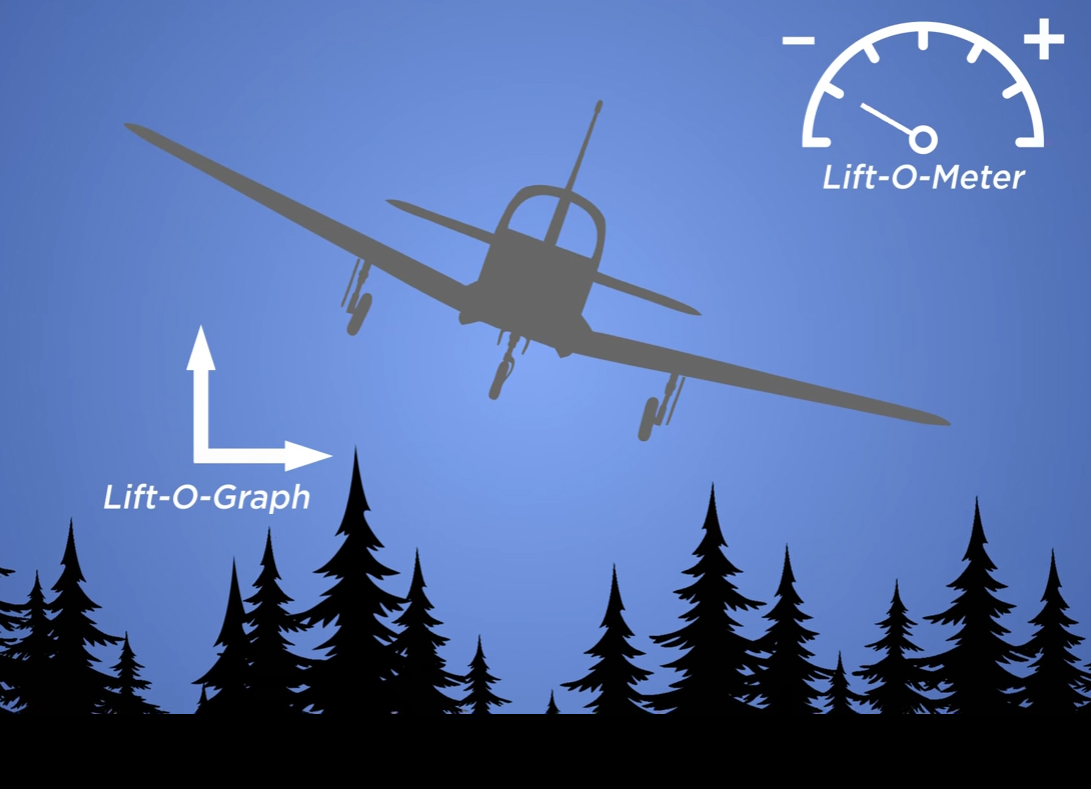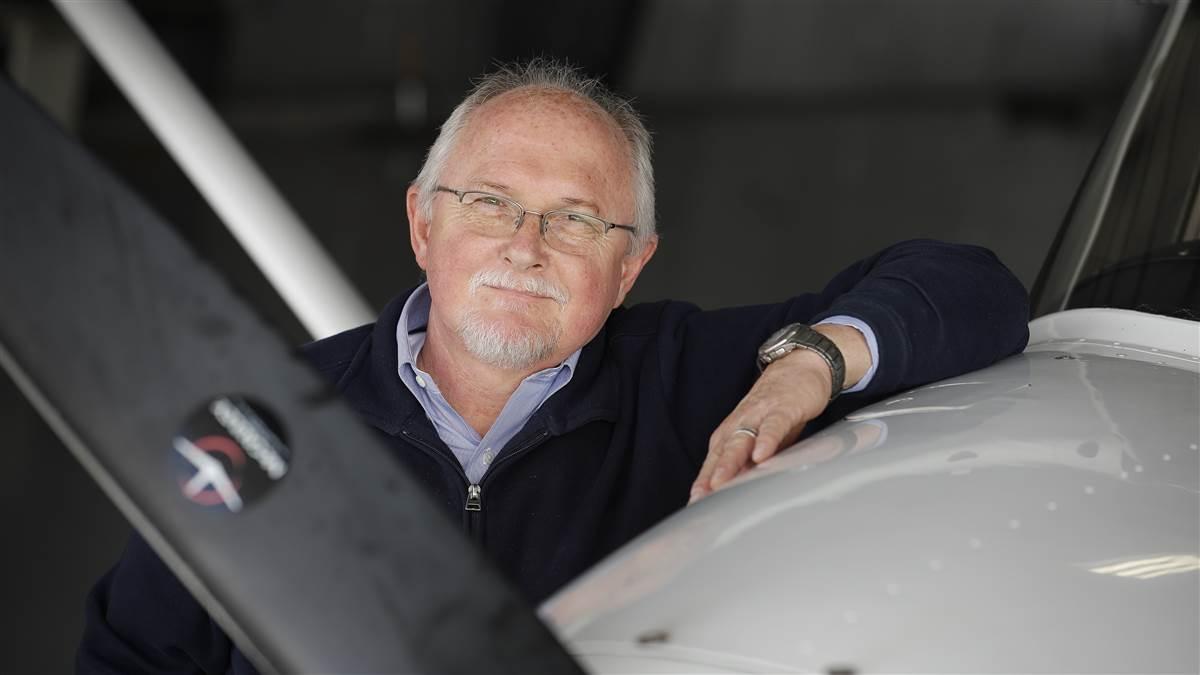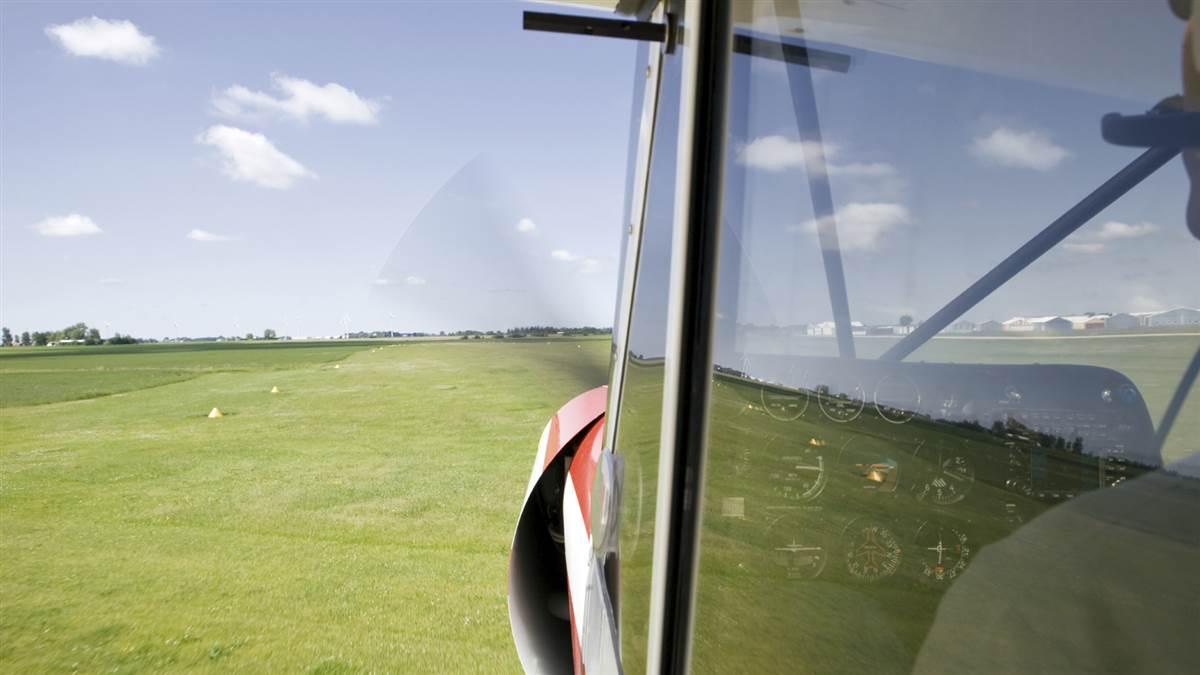Membership News & Notes: Your Place at the Airport
AOPA invites the community past the fences
By Ian J. Twombly
On one of AOPA President and CEO Mark Baker’s first days on the job he made it clear that one of his priorities was to work to make airports more inviting. Although most people would assume that’s by breaking down fences that are both virtual and physical, there are other ways to ensure the community understands the treasures a local airport can hold.

A mostly forgotten 50-year-old hangar at the south end of Frederick Municipal Airport turned out to be AOPA’s tool for bringing in the local community. Built for a long-shuttered aviation maintenance program at the local community college, the hangar had for years housed emergency equipment and other nonaviation assets. AOPA jumped at the chance to prove the hangar’s value to the airport when it came up for lease more than two years ago.
Throw in some maintenance upgrades, a sound system, two combination classrooms/meeting rooms, and a few coats of paint and today you have the National Aviation Community Center, a model for how the public can easily access an airport.
The NACC functions primarily as a corporate hangar, housing training airplanes and corporate aircraft. This makes it similar to the many thousands of hangars around the country that serve the same purpose. But by adding a Redbird FMX simulator and just a little signage, the hangar becomes a gateway.
In the past few years hundreds of community events have been held at the hangar, from weddings and graduation parties to Boy Scout camps and local business leader meetings. It’s also housed events during AOPA Fly-Ins, and Wings and Wheels, an AOPA-sponsored car and airplane show.
Michael Woods is responsible for making sure these events run smoothly. “The NACC is your place at the airport,” he says. Woods thinks the NACC can be a model for other airports, in part because it’s the same type of working bulk hangar found all over the country, with a few key elements added. “We’ve put a lot of thought into the equipment and the space,” he says. “Plus you can’t beat the location.”
Pilot Protection Services
Overcome unapproved medications
There could be alternatives to being grounded
By Gary Crump
The FAA’s medication usage policy remains a mystery to many pilots. A member who has been taking a heart medication called Tikosyn (Dofetilide) for many years for atrial fibrillation recently called AOPA for advice. Tikosyn is a Class III antiarrhythmic drug used to treat abnormal heart rhythms.
The heart’s electrical system “recharges” between beats in a process called repolarization. Sometimes, the heart muscle takes longer than normal to recharge. This electrical disturbance is called a prolonged QT interval, and it’s a side effect of dofetilide and other similar antiarrhythmic drugs. This concerns the FAA, and for that reason the agency doesn’t recognize the drug as appropriate for aviation activities.
The FAA carefully reviews medications for their adverse effects before determining their acceptability for use while flying. The disposition of the drug then becomes the policy for the drug’s acceptability, often regardless of an individual’s response to the drug in question.
However, policy can change over time, and as a medication’s history of use in the general population appears favorable, the FAA might reconsider and place the medication back in the “allowed for flying” category.
There are ways to pursue a review of your case with the FAA after being denied a medical certificate because of medication usage. (Remember that the underlying medical condition may be as much a factor in the denial as the medication). You will need a strong letter of support from your treating physician verifying how long you have been on the medication, the condition being treated, and that you have experienced no adverse side effects. You will then submit a request for reconsideration to the FAA and ask that the case be reviewed by the Federal Air Surgeon’s Therapeutics and Pharmacology committee.
The FAA allows many drugs, sometimes with certain limitations of restrictions, and the number of medications that are in the “no way” category is quite small. That said, if you and your treating doctor believe you could safely operate while using a particular medication, it definitely doesn’t hurt to ask the FAA to reconsider its position.
Gary Crump is AOPA director of Pilot Information Center medical certification.
Tips from PIC
AOPA medications database
One of the most common topics that members call AOPA about involves the acceptability of medications while flying.
In the early days of AOPA’s website, circa 2000, one of the first web-based databases AOPA made available online was the medications database. Prior to that, each medical specialist at AOPA had a copy of the Physician’s Desk Reference, and each time we inquired with the FAA about the status of a medication, we would update our copies to reflect the FAA policy of the drug in question. Developing that initial database was a time-consuming task. Today, we list about 1,000 medications in the online database. It’s one of the most frequently accessed aviation-related medication directories online, and we do our best to stay on top of the list to ensure accuracy.
Searching the medications list is easy using several different parameters. If you just want to browse, you can view the entire alphabetical list. Or, you can search for a drug by trade name, generic name, the medical condition treated by the drug, or by classification of the drug, such as antidepressant, low molecular weight heparin, or kinase inhibitor. Searching by medical condition, trade, or generic name will provide the best search results.
The list doesn’t contain every medication currently on the market, so if you don’t find the medication you are seeking, and it isn’t a brand-new drug, give us a call us at (800) 872-2672 and we may be able to find out the status for you. —Gary Crump
Medications and BasicMed
AOPA is working with the FAA to determine how medication regulations will apply to pilots taking advantage of BasicMed, which takes effect May 1 (see “BasicMed to Save Pilots, FAA Millions,” page 42). Check for updates online.
Web: www.aopa.org/pps
AOPA Air Safety Institute
Stay safe in the ‘red zone’
Risks increase closer to the ground
More than 80 percent of accidents involving stalls or spins originate from low-altitude maneuvering flight. But what defines low-altitude maneuvering flight?
Basically, every flight enters a brief maneuvering phase close to the ground while in the traffic pattern and during takeoff and landing. It’s par for the course. However, other low-altitude maneuvers—low-level passes, aerobatics, buzzing, formation flying, aerial observation or application flights, and canyon flying—require extra vigilance.
 Done right, maneuvering flight can demonstrate skill and professionalism. Unfortunately, some pilots fail to understand the hazards or deliberately take significant risks. Some may have successfully tempted fate on previous flights and are under the impression that success will repeat itself; others are tempted to demonstrate their skills, often operating impromptu. Their demise is frequently preceded by those famous last words: “Watch this!” It’s safe to say that when maneuvering flight goes wrong, it usually ends in loss of control.
Done right, maneuvering flight can demonstrate skill and professionalism. Unfortunately, some pilots fail to understand the hazards or deliberately take significant risks. Some may have successfully tempted fate on previous flights and are under the impression that success will repeat itself; others are tempted to demonstrate their skills, often operating impromptu. Their demise is frequently preceded by those famous last words: “Watch this!” It’s safe to say that when maneuvering flight goes wrong, it usually ends in loss of control.
The AOPA Air Safety Institute developed Margins of Safety: Low-Altitude Maneuvering to share the complexities of flying low and slow, and explore steps you can take to be safe when flying low to the ground where an inadvertent stall or spin may be unrecoverable. Think of this as flight in the “red zone.”
How do you guard your safety and that of your passengers? Take positive control of your aircraft below 2,500 feet agl and eliminate chitchat or other distractions. Also, practice flying at slow speeds at a safe altitude to get a feel for your aircraft’s handling during climbs, descents, and turns.
But before you climb in the cockpit, review this video; then share it with others on social media and at your flight school or flying club, so they, too, can understand the intricacies of maneuvering at low altitudes.
Video made possible by The Tom Davis Fund.
The finer points of takeoffs and landings
Have you ever wondered why perfect landings go unnoticed by passengers and onlookers, but the moment a landing is fumbled it gets plenty of un-desired attention? There is a way to fix this.
The AOPA Air Safety Institute’s Takeoffs and Landings video series shows you how to ace every departure and arrival. From flying stabilized approaches to perfecting crosswind landings, in-flight footage offers a great visual of what a safe and smooth operation should look like. In addition, CFIs share tips to master short field landings, determine an abort point during takeoff, and avoid overshooting the base-to-final turn.
The video series is made possible by the Canadian Owners and Pilots Association and the Donner Canadian Foundation.
Member Services
Ask Jim: Covering drones
Insurance policies are available for commercial drone use
Q: I am pursuing a Part 107 operating certificate and will be flying my drone commercially. Do you offer insurance for those devices?
A: Welcome to the new and exciting world of commercial drone operations. I’ve heard that the drone industry, still relatively in its infancy, can be compared to the internet in the mid-1990s—only our imagination can limit the potential uses for drones over the next decade, and beyond.
With all these new changes and demand for risk management, vast arrays of insurance products are available to insure against practically every type of legal operation. At AOPA, we have several insurance companies with many options, including liability only, additional coverage for payloads (cameras, equipment, et cetera), and options to cover the drone itself. Liability is required; however, the other two options can be added individually or together, and can insure up to any reasonable amount of coverage.
Purchasing an airplane with a partner makes ownership more affordable, but the logistics of financing with multiple people can get complicated. AOPA Aviation Finance President Adam Meredith shares more on financing an airplane in a partnership online.And there’s more good news: Because of the demand for these products, additional coverages can be included—for free. Examples include items such as nonowned coverage (if you have to rent or borrow a drone in the event yours is down for a covered claim) and medical payments (no-fault coverage to quickly pay for small injuries, and this applies before your liability limits).
One brief warning: Do not rely on your homeowners policy to cover your drone operation, especially if used for commercial purposes. Any commercial operation will be excluded, and many homeowners policies are starting to exclude coverage for recreational use.
Policies offered through AOPA do apply for commercial and commercial/recreational options.
Jim Pinegar is vice president of the AOPA Aviation Insurance Co. and owns and flies a Cessna 172.
 It can be difficult to find the right person to run an active hangar that pulls triple duty as an event space and public access point to the airport. Michael Woods perfectly fits the job. Woods is a private pilot working on his instrument rating and rotorcraft add-on. He’s also a Part 107 certificated drone operator and an FAASTEAM representative.
It can be difficult to find the right person to run an active hangar that pulls triple duty as an event space and public access point to the airport. Michael Woods perfectly fits the job. Woods is a private pilot working on his instrument rating and rotorcraft add-on. He’s also a Part 107 certificated drone operator and an FAASTEAM representative. 


